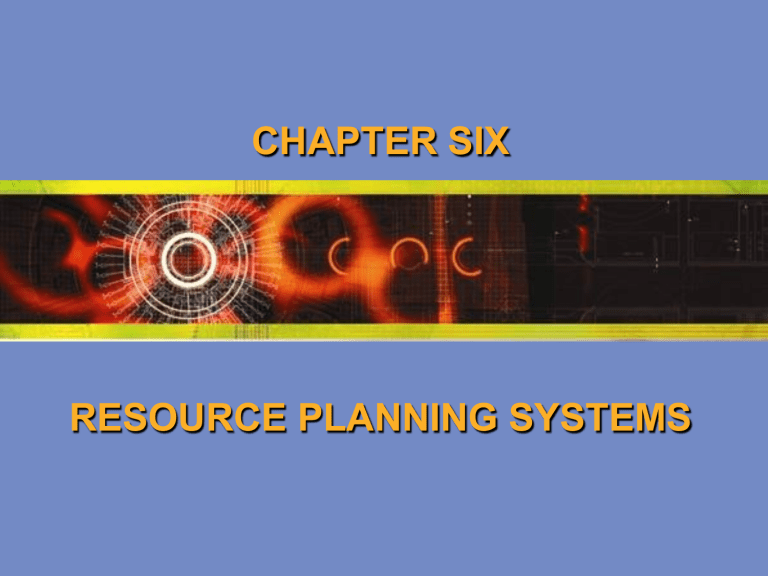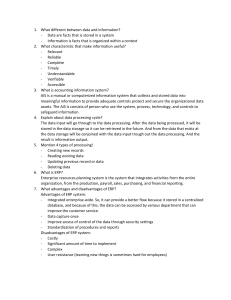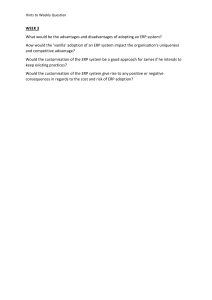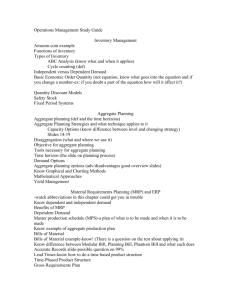
CHAPTER SIX RESOURCE PLANNING SYSTEMS 2 Introduction The organizations in the supply chain have to • • • • Meet due date Short lead time Right quality (TQM) Right cost (TQM) • Fully utilizing your capacity • Cutting all forms of waste 3 Learning Objectives • Understand the Production Planning process in an organization to meet due dates • Understand the Capacity Planning process in an organization to meet due dates • ERP System – Understand the limitations of legacy MRP systems – Describe an ERP system – Understand the advantages & disadvantages of ERP systems – Understand why many ERP implementations fail 4 A Broader View: Supply Chain Capacity Developing feasible operations schedules and inventory control systems to meet delivery due dates and minimize lead time is a very complex problem 5 Activity 1 What is the effect of missing a due date in one business in the supply chain. Problem: A missed due date or stock-out may cascade downstream, affecting the supply chain. 6 Production Planning • Operations planning is usually hierarchical & can be divided into three broad categories: • Long-range- Aggregate Production Plan - (APP) involves the construction of facilities & major equipment purchase • Intermediate- Master Production Schedule- (MPS) Shows the quantity & timing of end items • Short-range- Materials Requirement Planning- MRP • detailed planning process for components & parts to support the master production schedule 7 Master Production Scheduling A detailed disaggregation of the aggregate production plan, listing the exact end items to be produced by a specific period Frequent changes to the MPS may create system nervousnessTime fence separates the planning horizon into two segments – Firmed Segment from current period to several weeks into future. Can only be altered by senior management. – Tentative segment from end of the firmed segment to several weeks farther into the future. 8 Activity 2 What is the master production schedule for a service firm (a doctor office)? 9 Materials Requirement Planning MRP A computer-based materials management system. The materials requirement plan calculates the exact quantities, need dates, & planned order releases for subassemblies & materials required to manufacture the final products listed on . Bill of Materials (BOM) An engineering document that shows an inclusive listing of all component parts & assemblies making up the final product. 10 The Bill of Materials 11 Capacity Planning Resource Requirement Planning (RRP), a long-range capacity planning module, checks whether aggregate resources are capable of satisfying the aggregate production. Resources considered include gross labor hours & machine hours. Medium-range capacity plan, or rough-cut capacity plan (RCCP), used to check feasibility of MPS. Converts MPS from production needed to capacity required, then compares it to capacity available. Capacity requirement planning (CRP) is a short-range capacity planning technique that is used to check the feasibility of the material requirements plan. 12 Activity 3 Wal-Mart is one of the pioneers of the supply chain. Why Wal-Mart faces shortage in the supplies during hurricanes? 13 Development of Legacy MRP Systems Materials Requirement Planning (MRP) Links internal operations, purchasing, and inventory control to improve purchasing, production, and delivery MRP –Closed Loop Added capacity requirement planning and feed back to describe the progress of the orders being manufactured Manufacturing Resource Planning (MRPII) Integrates the internal functions of an organization to coordinate manufacturing plans with sales while providing the management with essential accounting and financial14 functions Disadvantages Legacy MRP Systems By end of the 20th century, U.S. business was changing and firms were building multiplant international sites, – It does not integrate all the functions – Its primary focus on one unit’s internal operations only. – It lacks the capability to directly interface with external supply chain members. – The continues modification of these systems made them complex and they are not user friendly – Lack analytical capabilities. 15 Development of Enterprise Resource Planning 16 ERP Software Providers • SAP AG, a German firm, is the world’s leading ERP software provider & the world’s third-largest software provider. • Oracle is the world’s leading supplier of information management software, world’s 2nd largest software company, & serves over 13,000 customers. • Leader in the human resources application market serves customer around the globe. • • • Baan (of SSA) provides application solutions to more than 15,000 customer sites worldwide. 17 Implementing ERP Systems Single integrator- applications from one vendor. – Problem: A user’s processes must conform to the approaches used in the software logic. Conforming a company’s process to a software program is a radical departure from conventional practice. Best-of-breed- use best application for each supply chain function – Problem: multiple databases may have to be used to link the multiple applications from different vendors. 18 Activity 4 What is the effect of using different modules from different providers? GM decided to use all modules from SAP except Human Resources module from People Soft. 19 The Rapid Growth of ERP The use of ERP has gradually spread from manufacturing to the service sector. Contributing factors of rapid ERP growth: – Reduce costs & deal w/Y2K problem. – Development of computer technology. 20 Advantages of ERP • • • • • Real time and up to date information that enables management to take better decisions that affect the supply chain Communicates with supply chain members about operations changes with little delay Increases supply chain visibility which leads to reductions of the bullwhip effect Standardizes processes & eliminates redundant resources Tracks employees’ performance 21 Activity 5 What are the major disadvantages of ERP Systems • Substantial capital investment is needed to implement the system. • The adopting firm must change its business model & associated processes to fit the built-in business model designed into the ERP system. 22 Implementing ERP Systems- Cont. Many implementations have failed due to: – Lack of top management commitment – Lack of adequate resources – Lack of proper training (prevention) – Lack of communication – Incompatible system environment 23 Activity 6 What do you think is the right way to implement ERP system? What do you think is the most important aspect that the organization has to pay attention to 24 Florida Chapter of the America SAP User Group (ASUG) • About 450 companies reported to be affiliated with the Florida Chapter of the Americas SAP User Group (ASUG) – American Airline, Jet Blue – Coca cola, PepsiCo, – Walt Disney Co. Burger King, Starbucks Corporation – Allstate Insurance , At&T, T-Mobile – Chevron, Exxon Mobile , Hess corporation, Florida Crystals Corporation – Siemens, Cisco, HP, IBM, Intel, Microsoft, McAfee, Lexmark, Rockwell Automation, Honeywell International – City of Tacoma , Orange county public schools, Polk county public schools, Sacramento Municipal Utility District , South Florida Water Management District , State of Florida - Department of Revenue, Broward County Public Schools – Johnson & Johnson, Kraft , Nestle, Mars, Inc., NetApp, Inc – Eastman Kodak , Proctor & Gamble , Whirlpool Corporation, Hallmark Cards, Inc. – Mitsubishi, BMW, Volvo Aero Services Corp. Bombardier Aerospace , Deere & Company – Florida Power & Light , TECO Energy, Gainesville Regional Utilities ,OfficeMax , 25 The Home Depot , Computer Associates International Inc.



